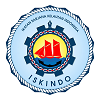Pemetaan Habitat Bentik Berbasis Objek Menggunakan Drone Di Perairan Pulau Gili Labak, Sumenep
Abstract
ABSTRAK
Pemetaan habitat bentik menggunakan drone memiliki kendala terkait kodisi cuaca dan lingkungan, seperti kecepatan angin dan sun glint yang dapat mengganggu pengambilan gambar dan klasifikasi gambar. Penelitian ini bertujuan untuk mengetahui sudut sensor drone yang optimal, waktu penerbangan drone terbaik di lokasi penelitian, serta mengetahui tingkat akurasi algoritma support vector machine menggunakan metode OBIA. Penelitian ini dilaksanakan di perairan Pulau Gili Labak pada bulan Oktober 2022 menggunakan drone DJI Phantom 4. Penelitian ini menerapkan dua sudut sensor 45° dan 90° serta waktu pengambilan pukul 08:00; 09:30; 13:15; 14:45. Klasifikasi citra drone menggunakan metode OBIA menggunkan metode contextual editing pada level 1 (perairan dangkal). Level 2 menggunakan klasifikasi terbimbing menggunakan algoritma klasifikasi machine learning yaitu support vector machine (SVM) dengan input themathic layer dari data lapangan. Klasifikasi habitat bentik dilakukan pada 6 kelas dengan penerapan skala segmentasi 25, 50, 70, 100. Berdasarkan hasil pengambilan gambar waktu terbaik menerbangkan drone pada pukul 13:15 menggunakan sudut sensor 90º dilokasi penelitian, diperoleh nilai overall accuracy sebesar 84.06% serta nilai kappa 0.78656 pada skala segmentasi 50 dengan algoritma support vector machine.
Kata kunci: pemetaan, habitat bentik, OBIA, drone, Pulau Gili Labak
ABSTRACT
Benthic habitat mapping using drones has constraints related to weather and environmental conditions, such as wind speed and sun glint that can interfere with image capture and image classification. This study aims to determine the optimal drone sensor angle, the best drone flight time at the research location, and determine the accuracy of the support vector machine algorithm using the OBIA method. This research was conducted in the waters of Gili Labak Island in October 2022 using a DJI Phantom 4 drone. This research applied two sensor angles of 45° and 90° and the capture time at 08:00; 09:30; 13:15; 14:45. Classification of drone imagery using the OBIA method utilizes contextual editing at level 1 (shallow water). Level 2 uses guided classification using a machine learning classification algorithm, namely support vector machine (SVM) with themathic layer input from field data. Benthic habitat classification was performed on 6 classes with the application of segmentation scales of 25, 50, 70, 100. Based on the results of taking pictures of the best time to fly the drone at 13:15 using a 90º sensor angle at the research location, an overall accuracy value of 84.06% was obtained and a kappa value of 0.78656 on a segmentation scale of 50 with the support vector machine algorithm.
Keywords: Mapping, Benthic Habitats, OBIA, Gili Labak Island
Full Text:
PDFReferences
Anggoro, A., Siregar, V.P., Agus, S.B. (2017). Multiscale Classification for Geomorphic Zone and Benthic Habitats Mapping Using OBIA Method in Pari Island. Jurnal Penginderaan Jauh, 14(2), 89-93.
Chong, W.S., Zaki, N.H.M., Hossain, M.S., Muslim, A.M., Pour, A.B. (2021). Introducing Theil-Sen Estimator For Sun Glint Correction of UAV Data For Coral Mapping. Geocarto International, 37(15), 4527:4556.
Congalton, R.G., Green, K. (2009). Assessing The Accuracy of Remotely Sensed Data. Principles and Practices. 2nd Edition. New York: CRC Press Taylor and Francis Group.
Cox, C., Munk, W. (1954). Measurement Of The Roughness Of The Sea Surface From Photographs Of The Sun’s Glitter. Journal of The Optical Society of America, 44(11), 838-850.
Doukari, M., Batsaris, M., Papakonstantinou, A., Topouzelis, K. (2019). A Protocol For Aerial Survey in Coastal Areas Using UAS. Remote Sensing, 11, 1913. https://doi.org/10.3390/rs11161913.
Doukari, M., Batsaris, M., Topouzelis, K. (2021). UASea: A Data Acquisition Toolbox for Improving Marine Habitat Mapping. Drones, 5, 73. https://doi.org/10.3390/drones5030073.
Doukari, M., Topouzelis, K. (2022). Overcoming the UAS Limitations in The Coastal Environment For Accurate Habitat Mapping. Remote Sensing Applications: Society and Environment, 26. https://doi.org/10.1016/j.rsase.2022.100726.
Duffy, J.P., Cunliffe, A.M., DeBell, L., Sandbrook, C., Wich, S.A., Shutler, J.D., Myers-Smith, I.H., Varela, M.R., Anderson, K. (2017). Location, location, location: Considerations When Using Lightweight Drones in Challenging Environments. Remote Sensing in Ecology and Conservation, 4, 7-9. https://doi.org/10.1002/rse2.58.
Goodman, J.A., Purkis, S.J., Phinn, S.R. (2013). Coral Reef Remote Sensing. A guide for Mapping, Monitoring, and Management.Springer: Netherlands.
Green, E., Edwards, A.J., Clark, C. (2000). Remote Sensing Handbook for Tropical Coastal Management. Unesco, Paris, France, 316p.
Hamad, I.Y., Staehr, P.A.U., Rasmussen, M.B., Sheikh, M. (2022). Drone-Based Characterization of Seagrass Habitats in the Tropical Waters of Zanzibar. Remote Sensing, 14, 680. https://doi.org/10.3390/rs14030680.
Hamylton, S.M. (2017). Mapping Coral Reef Environment: A Review Of Historical Methods, Recent Advances and Future Opportunities. Progress in Physical Geography, 41(6), 803-833. https://doi.org/10.1177/0309133317744998.
Hartoni., Siregar, V.P., Wouthuyzen, S., Agus, S.B. (2022). Object Based Classification of Benthic Habitat Using Sentinel 2 Imagery by Applying with Support Vector Machine and Random Forest Algorithms in Shallow Waters of Kepulauan Seribu, Indonesia. Biodiversitas, 23(1), 514-520. https://doi.org/10.13057/biodiv/d230155.
Hohle, J. (2008). Photogrammetric Measurements in Oblique Aerial Images. Photogrammetrie, Fernerkundung, Geoinformation, 1, 7-14.
Joyce, K.E., Duce, S., Leahy, S.M., Leon, J., Maier, S.W. (2018). Principles and Practice of Acquiring Drone-Based Image Data In Marine Environments. Marine and Freshwater Research, 70(7). http://dx.doi.org/10.1071/MF17380.
Klemas, V.V. (2015). Coastal and Environmental Remote Sensing From Unmanned Aerial Vehicles: An Overview. J. Coastal research, 315, 1260-1267. https://doi.org/10.2112/JCOASTRES-D-15-00005.1.
Landis, J.R., Koch, G.G. (1977). The Measurement of Observer Agreement for Categorical Data. Biometrics, 33, 159-174. https://doi.org/10.2307/2529310.
Mastu, L.O.K., Nababan, B., Panjaitan, J.P. (2018). Pemetaan Habitat Bentik Berbasis Objek menggunakan Citra Sentinel-2 Di Perairan Pulau Wangi-Wangi Kabupaten Wakatobi. Jurnal Ilmu dan Teknologi Kelautan Tropis, 10(2), 381-396. https://doi.org/10.29244/jitkt.v10i2.21039.
Mount, R. (2005). Acquisition of Through-Water Aerial Survey Images: Surface Effects and The Prediction Of Sun Glitter and Subsurface Illumination. Photogrammetric Engineering & Remote Sensing, 71(12), 1407-1415. http://dx.doi.org/10.14358/PERS.71.12.1407.
Muslim, A.M., Chong, W.S., Safuan, C.D.M., Khalil, I., Hossain, M.S. (2019). Coral Reef Mapping of UAV: A Comparison of Sun Glint Correction Methods. Remote Sensing, 11, 2422. https://doi.org/10.3390/rs11202422.
Nababan, B., Mastu, L.O.K., Idris, N.H., Panjaitan, J.P. (2021). Shallow-Water Benthic Habitat Mapping Using Drone with Object Based Image Analyses. Remote sensing, 13, 4452. https://doi.org/10.3390/rs13214452.
Nagalkerken, I., Sheaves, M., Baker, R., Connolly, R.M. (2015). The Seascape Nursery: a Novel Spatial Approach to Identify and Manage Nurseries for Coastal Marine Fauna. Fish Fish, 16, 362-371. https://doi.org/10.1111/faf.12057.
Nahirnick, N.K., Reshitnyk, L., Campbell, M., Hessing-Lewis, M., Costa, M., Yakimishyn, J., Lee, L. (2019). Mapping With Confidence; Delineating Seagrass Habitats Using Unoccupied Aerial Systems (UAS). Remote Sensing in Ecology and Conservation, 7,121-135. https://doi.org/10.1002/rse2.98.
Oleksyn, S., Tesetto, L., Raoult, V., Joyce, K.E., Williamson, J.E. (2021). Going Batty: The Challenges and Opportunities of Using Drones to Monitor the Behaviour and Habitat Use of Rays. Drones. 5, 12. https://doi.org/10.3390/drones5010012.
Prabowo, N.W., Siregar, V.P., Agus, S.B. (2018). Klasifikasi Habitat Bentik Berbasis Objek dengan Algoritma Support Vector Machines dan Decision Tree Menggunakan Citra Multispektral SPOT-7 di Pulau Harapan dan Pulau Kelapa. Jurnal Ilmu dan Teknologi Kelautan Tropis, 10(1), 123-134. https://doi.org/10.29244/jitkt.v10i1.21670.
Prayuda, B. (2014). Panduan Teknis Pemetaan Habitat Dasar Perairan Laut Dangkal. Suyarso, editor. Jakarta (ID): CRITC COREMAP LIPI.
Raber, G.T., Schill, S.R. (2019). Reef Rover: A Low-Cost Small Autonomous Unmanned Suface Vehicle (USV) For Mapping and Monitoring Coral Reefs. Drones, 3, 38.
https://doi.org/10.3390/drones3020038
Roelfsema, C., Kovacs, E., Ortiz, J.C., Wolff, N.H., Callaghan, D., Wettle, M., Ronan, M., Hamylton, S.M., Mumby, P.J., and Phinn, S. (2018). Coral Reef Habitat Mapping: A Combination Of Object-Based Image Analysis and ecological modelling. Remote Sensing of Environment, 208, 27-41. https://doi.org/10.1016/j.rse.2018.02.005.
Sambodo, A.P., Sukmawijaya, A., Budianto, Y. (2019). Pengaruh sudut kamera uav terhadap kualitas foto udara wilayah bencana longsor (studi kasusu: bentanglahan vulkanik transisi tersier kuarter). Seminar Nasinal Geomatika, 3, 1001. http://dx.doi.org/10.24895/SNG.2018.3-0.957.
Tzotsos, A. (2006). A Support Vector Machine Approach For Object Based Image Analysis. 2006. In: 1st International Conference on Object-Based Image Anlysis, OBIA, Salzburg, Austria, July 4-5. DOI: 10.1007/978-3-540-77058-9_36. 6 p.
Velez, S., Vacas, R., Martin, H., Ruano-Rosa, D., Alvares, S. 2022. High-Resolution UAV RGB Imagery Dataset For Precision Agriculture and 3D Photogrammetric Reconstruction Captured Over Pistachio Orchard (Pistacia vera L.) in Spain. Data, 7, 157. https://doi.org/10.3390/data7110157.
Wahidin, N., Siregar, V.P., Nababan, B., Jaya, I., Wouthuyzend, S. (2015). Object-Based Image Analysis For Coral Reef Benthic Habitat Mapping With Several Classification Algorithms. Procedia Environmental Sciences, 24, 222-227. https://doi.org/10.1016/j.proenv.2015.03.029.
Zeybek, M., Taskaya, S., Elkhrachy ,I., Tarolli, P. 2023. Improving the Spatial Accuracy of UAV Platforms Using Direct Georeferencing Methods: An Application For Steep Slopes. Remote Sensing, 15, 2700. https://doi.org/10.3390/rs15102700.
DOI: https://doi.org/10.21107/jk.v17i1.24518
Refbacks
- There are currently no refbacks.

This work is licensed under a Creative Commons Attribution 4.0 International License.

Jurnal Kelautan by Program Studi Ilmu Kelautan is licensed under a Creative Commons Attribution 4.0 International License.
Published by: Department of Marine Sciences, Trunojoyo University of Madura













